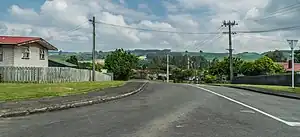Pukehangi
Pukehangi is a western suburb of Rotorua in the Bay of Plenty Region of New Zealand's North Island.
Pukehangi | |
|---|---|
 Susan Street | |
| Coordinates: 38.136306°S 176.207755°E | |
| Country | New Zealand |
| City | Rotorua |
| Local authority | Rotorua Lakes Council |
| Electoral ward | Te Ipu Wai Auraki General Ward |
| Area | |
| • Land | 229 ha (566 acres) |
| Population (June 2022)[2] | |
| • Total | 5,510 |
| Western Heights | ||
| Ngongotahā Valley |
|
Mangakakahi |
| Fordlands | Sunnybrook |
History
In 2017, Rotorua District Council identified Pukehangi as a key area for future residential development.[3] An 89-section subdivision and a 33-section subdivision were both announced that year.[4] More sections were due to become available in 2019.[5]
In December 2018, landowners of farmland west of the suburb sought planning consent to develop new residential areas.[6] The plan change was approved by the Rotorua District Council and Ministry for the Environment during 2019.[7][8] It was opened up it to public submissions in January 2020.[8]
In 2019, a Pukehangi rental home was the subject of a 7-month legal dispute between a landlord and tenant, which ended with the High Court terminating the tenancy.[9]
Demographics
Pukehangi covers 2.29 km2 (0.88 sq mi)[1] and had an estimated population of 5,510 as of June 2022,[2] with a population density of 2,406 people per km2.
| Year | Pop. | ±% p.a. |
|---|---|---|
| 2006 | 4,941 | — |
| 2013 | 4,887 | −0.16% |
| 2018 | 5,277 | +1.55% |
| Source: [10] | ||
Pukehangi had a population of 5,277 at the 2018 New Zealand census, an increase of 390 people (8.0%) since the 2013 census, and an increase of 336 people (6.8%) since the 2006 census. There were 1,758 households, comprising 2,496 males and 2,778 females, giving a sex ratio of 0.9 males per female, with 1,362 people (25.8%) aged under 15 years, 1,080 (20.5%) aged 15 to 29, 2,151 (40.8%) aged 30 to 64, and 684 (13.0%) aged 65 or older.
Ethnicities were 65.5% European/Pākehā, 44.7% Māori, 5.7% Pacific peoples, 5.9% Asian, and 1.4% other ethnicities. People may identify with more than one ethnicity.
The percentage of people born overseas was 13.4, compared with 27.1% nationally.
Although some people chose not to answer the census's question about religious affiliation, 53.6% had no religion, 34.8% were Christian, 2.6% had Māori religious beliefs, 1.0% were Hindu, 0.5% were Buddhist and 1.2% had other religions.
Of those at least 15 years old, 528 (13.5%) people had a bachelor's or higher degree, and 861 (22.0%) people had no formal qualifications. 399 people (10.2%) earned over $70,000 compared to 17.2% nationally. The employment status of those at least 15 was that 1,911 (48.8%) people were employed full-time, 576 (14.7%) were part-time, and 285 (7.3%) were unemployed.[10]
| Name | Area (km2) | Population | Density (per km2) | Households | Median age | Median income |
|---|---|---|---|---|---|---|
| Pukehangi North | 1.18 | 2,706 | 2,293 | 819 | 28.0 years | $22,900[11] |
| Pukehangi South | 1.11 | 2,571 | 2,316 | 939 | 40.2 years | $32,800[12] |
| New Zealand | 37.4 years | $31,800 |
References
- "ArcGIS Web Application". statsnz.maps.arcgis.com. Retrieved 26 December 2022.
- "Population estimate tables - NZ.Stat". Statistics New Zealand. Retrieved 25 October 2022.
- Guy, Alice (15 September 2017). "Rotorua's Pukehangi, Ngongotaha and Eastside key areas for development". New Zealand Media and Entertainment. Rotorua Daily Post.
- Arthur-Worsop, Stephanie (17 June 2017). "33 lot subdivision goes up for sale". New Zealand Media and Entertainment. Rotorua Daily Post.
- Olley, Samantha (10 January 2019). "126 new Rotorua homes consented in 2018 but many more needed". New Zealand Media and Entertainment. Rotorua Daily Post.
- Makiha, Kelly (6 December 2018). "Residential plans for farmland bordering Pukehangi, west of Rotorua". No. New Zealand Media and Entertainment. Rotorua Daily Post.
- Sparks, Zizi (28 March 2019). "Council recommends Government process to free up land for housing in Pukehangi quickly". New Zealand Media and Entertainment. Rotorua Daily Post.
- "Pukehangi Heights Plan Change proceeds". scoop.co.nz. Rotorua District Council. 21 January 2020.
- Sparks, Zizi (20 November 2019). "Tenancy Tribunal finding gives Rotorua landlord possession, 229 days after 90-day notice issued". New Zealand Media and Entertainment. Rotorua Daily Post.
- "Statistical area 1 dataset for 2018 Census". Statistics New Zealand. March 2020. Pukehangi North (199100) and Pukehangi South (199200).
- 2018 Census place summary: Pukehangi North
- 2018 Census place summary: Pukehangi South